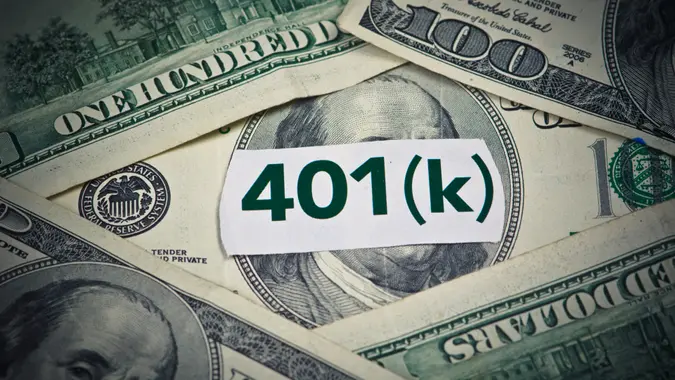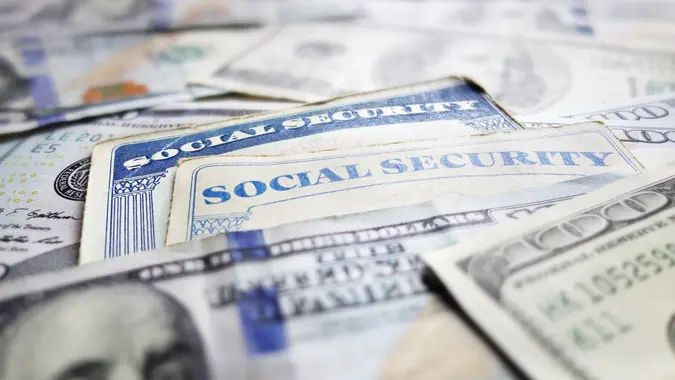What Falling Interest Rates Could Mean for Your 401(k) and IRA Into 2026

Commitment to Our Readers
GOBankingRates' editorial team is committed to bringing you unbiased reviews and information. We use data-driven methodologies to evaluate financial products and services - our reviews and ratings are not influenced by advertisers. You can read more about our editorial guidelines and our products and services review methodology.

20 Years
Helping You Live Richer

Reviewed
by Experts

Trusted by
Millions of Readers
In March 2022, the Federal Reserve began aggressively raising interest rates, a trend that lasted until mid-2023. Rates reached a high-water mark of 5.25% to 5.5%. In late 2024, the rates began to come down in three 0.25% increments, and in mid-September, the Fed cut rates again by 0.25% due to a stalling job market.
Changes in interest rate benchmarks create a ripple across the economy, affecting businesses, mortgages, prices and markets. If you’re retired or planning ahead, it’s important to understand just what this means and how it affects your 401(k) and Roth IRA.
Why the Federal Reserve Cuts Rates
The Federal Reserve’s job is to keep the U.S. economy healthy, but that doesn’t always mean its decisions are best for individual investors. It makes decisions based on what’s best for stabilizing inflation and maximizing employment across the country.
The Federal Reserve looks at data and objective analysis to determine what’s best for the long-term interests of the U.S. economy. This institution can both raise or lower the benchmark interest rates that influence banks when they lend out money. When the Fed raises the target, borrowing becomes more expensive. This cools things down if inflation is getting too high. On the other hand, if the Fed cuts the target rate, borrowing from banks becomes cheaper. If the economy is stagnant, lowering rates helps jumpstart economic growth.
When the target interest rate drops, businesses and consumers benefit, but saving becomes less attractive. More businesses will take out loans to pursue new ventures or projects, stimulating the economy. Individuals will find it cheaper to take on a mortgage or car loan. Lower rates also mean banks lower the interest you receive from savings accounts and CDs, however, causing many to turn from saving to spending or investing.
What Rate Cuts Mean for Retirees
Those who have been investing in or depending on retirement accounts, such as a 401(k) or Roth IRA, should use this information to make informed decisions about their financial future. Here are a few ways that these changes can affect your retirement savings.
Stocks
If you’re investing in stocks through your retirement accounts, you may benefit from these rate cuts. When businesses can borrow at a lower rate and consumers have reason to spend more, equities tend to rise.
Retirees watching their portfolios rise in value will welcome this, but it can lead to stocks hitting unsustainable levels. Changing your investment strategy to chase hot industries or stocks can lead to losses when the market corrects.
Bonds
Some retirees use their accounts to invest in fixed-income investments, such as bonds. Bonds have less risk than stocks and provide a regular interest payment until they mature. If you have bonds already, a rate cut makes these existing assets relatively more valuable. Because the new bonds coming out pay less interest, your existing bond becomes more attractive and will sell at a higher price than you originally paid.
Savings
Retirees who put their money into savings accounts or CDs should expect their returns to drop along with the rates. If you’ve already invested in long-term CDs, you won’t need to take any action and can enjoy the same returns. However, with rates expected to continue dropping through 2026, you should be cautious about locking yourself into new CDs unless you’re OK with settling for lower rates.
What To Do
You can still maintain your financial security through rate cuts. Don’t panic or make drastic changes that can put your retirement portfolio in jeopardy. With more rate cuts expected in 2025 and 2026, it may be a good idea to buy bonds and capitalize on the current rate of fixed-income payments now before the returns drop.
Keep in mind that trying to guess or time the Fed’s next move can lead to losses. Make sure you have a diverse investment portfolio that can withstand volatility. Balancing your retirement accounts between stocks, bonds and fixed-income investments can keep your finances stable through any interest rate environment.
More From GOBankingRates
 Written by
Written by  Edited by
Edited by 

























